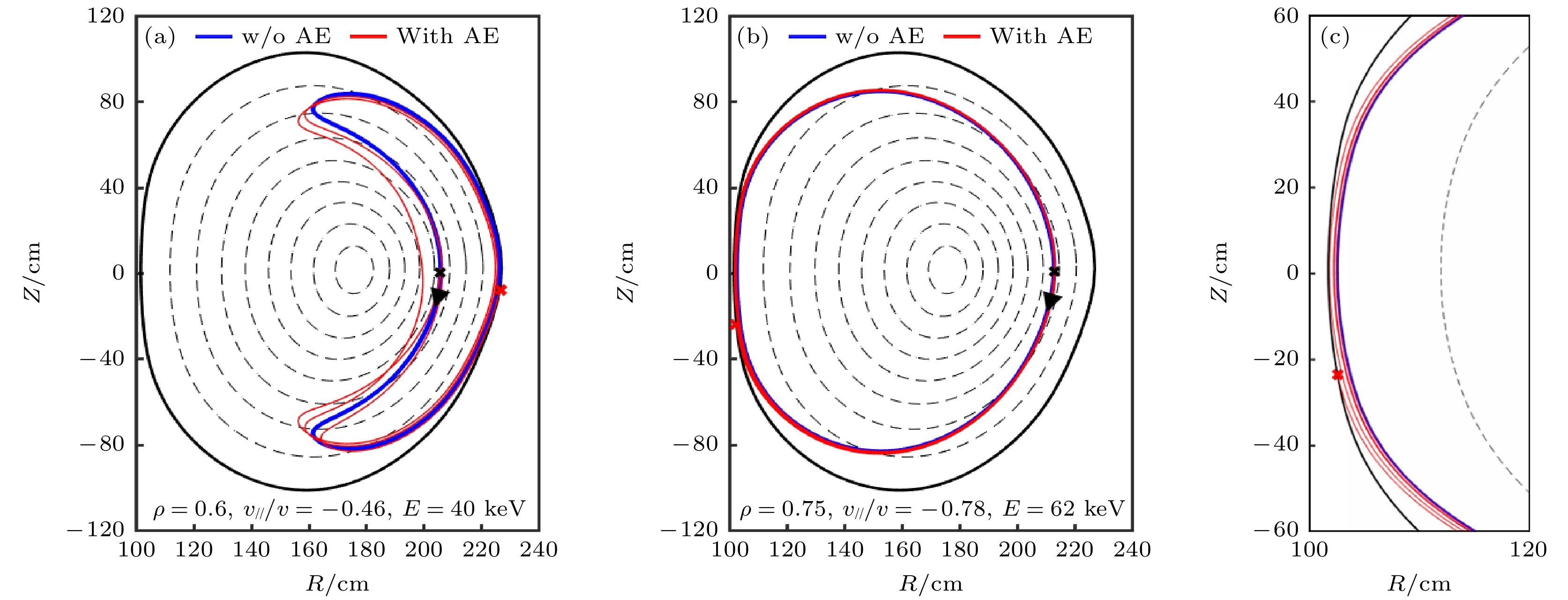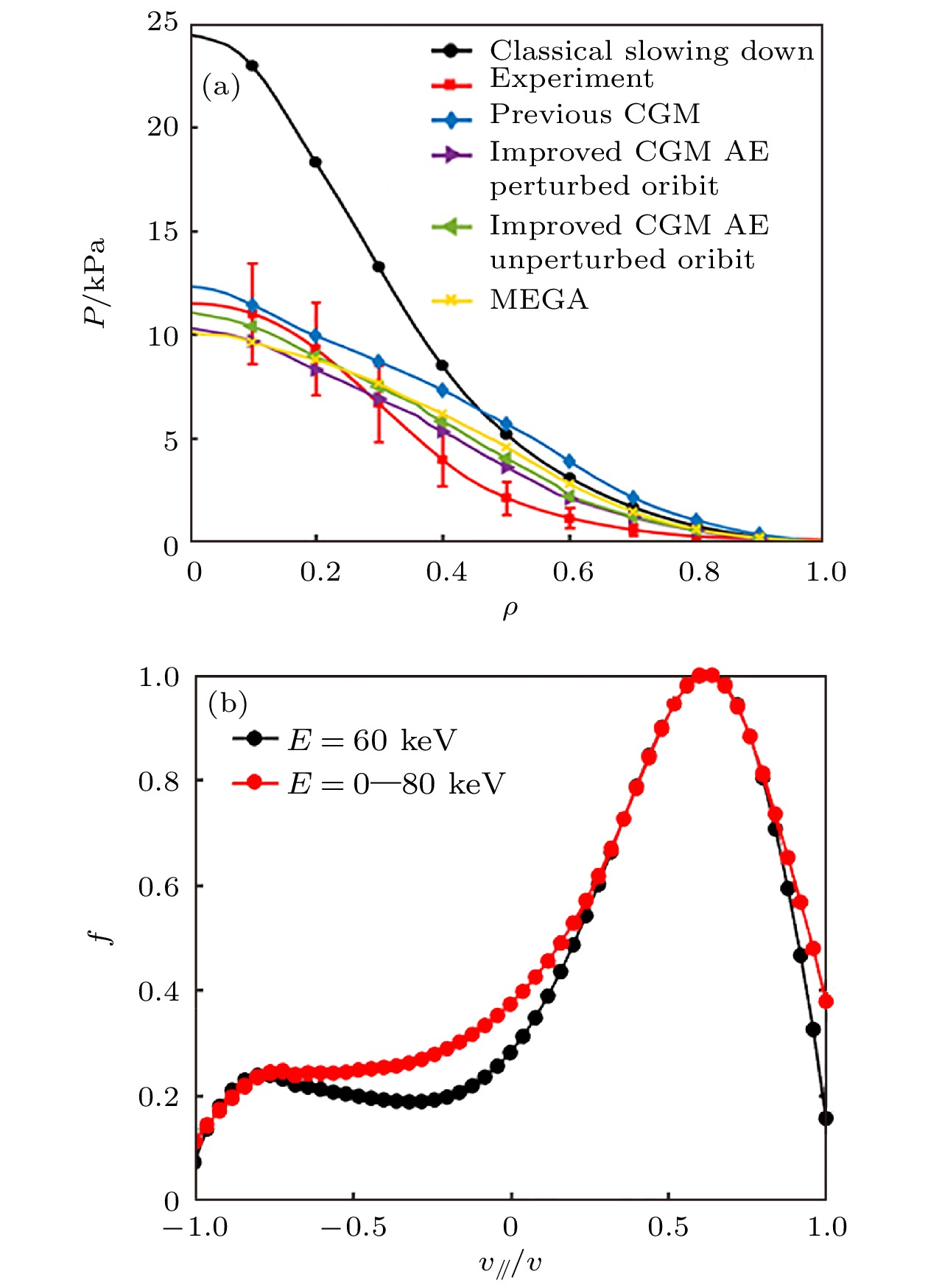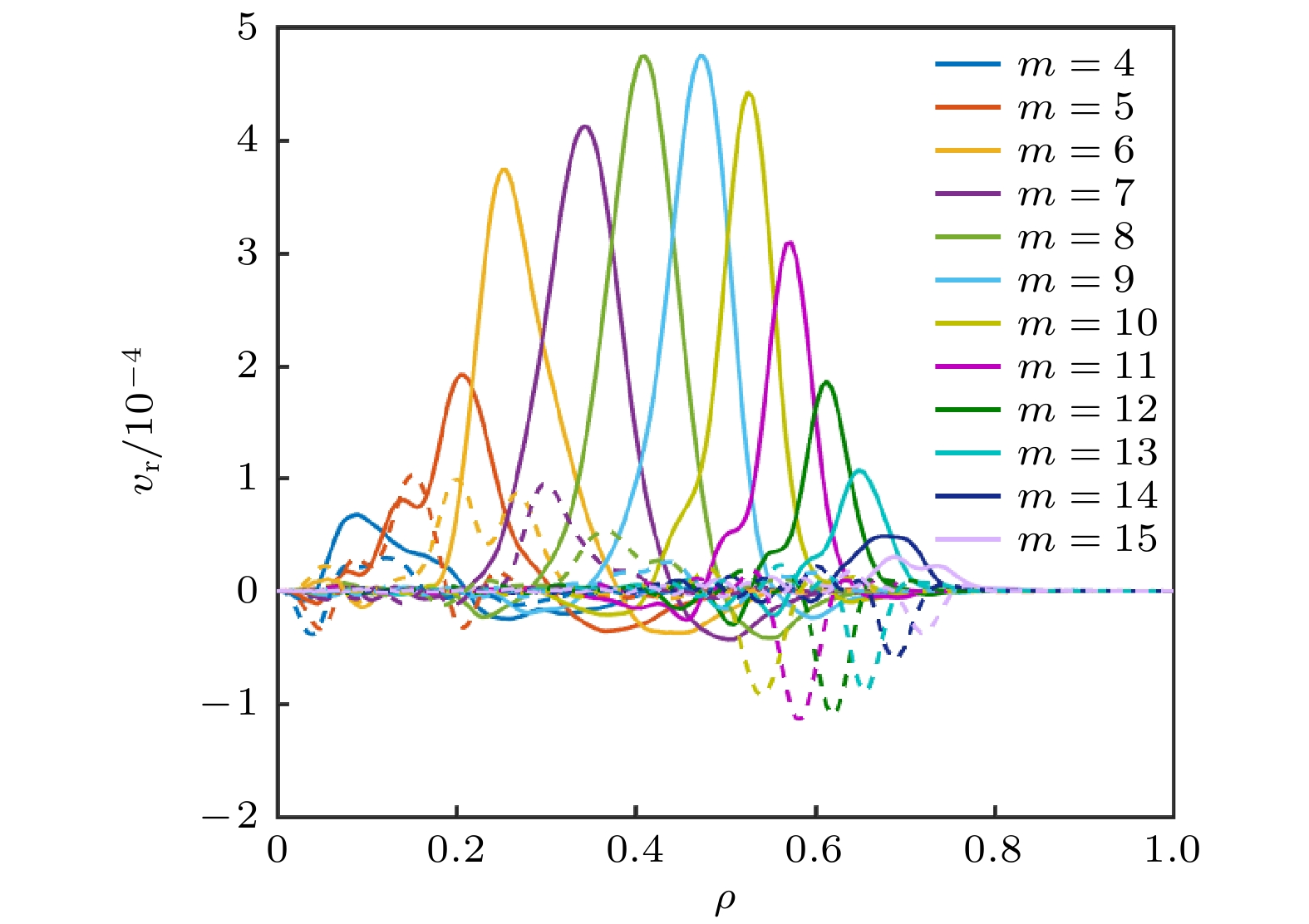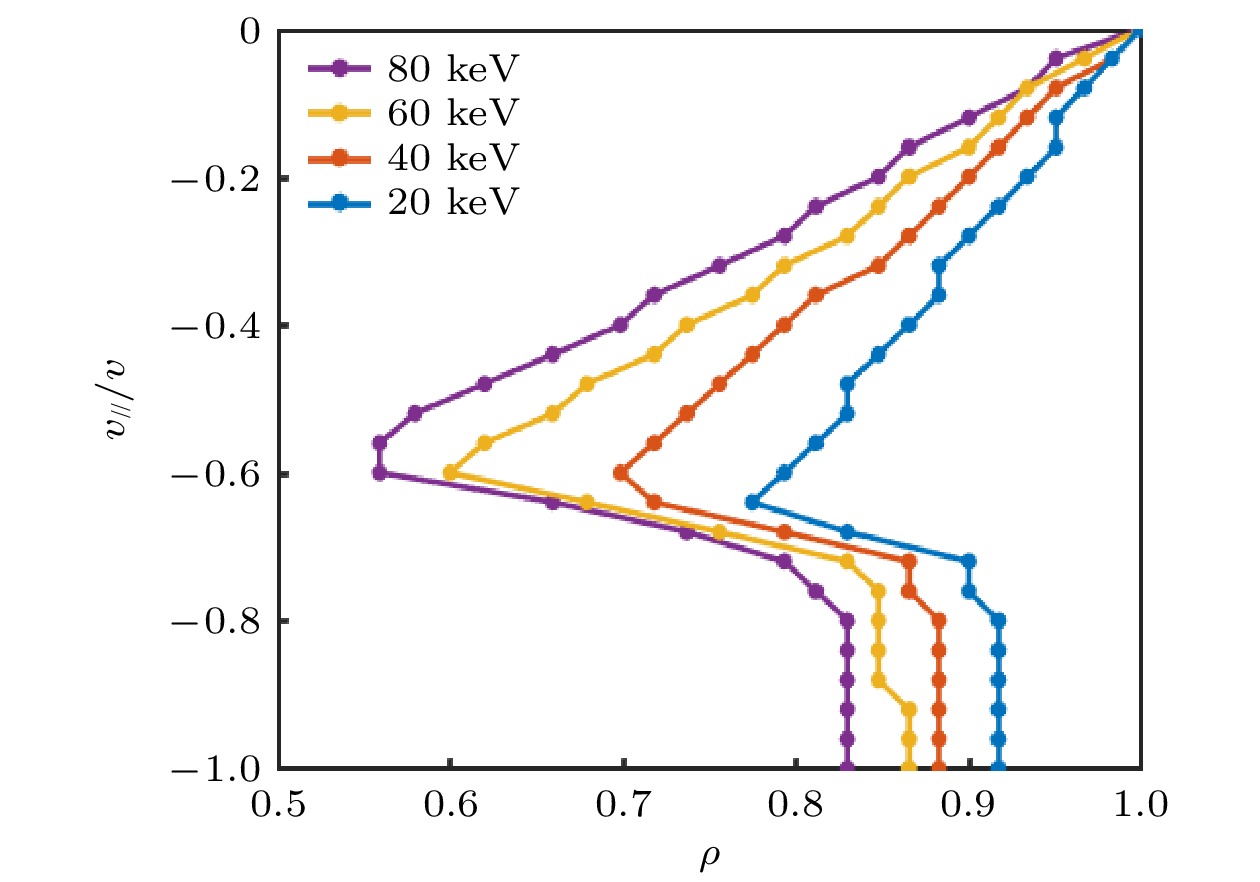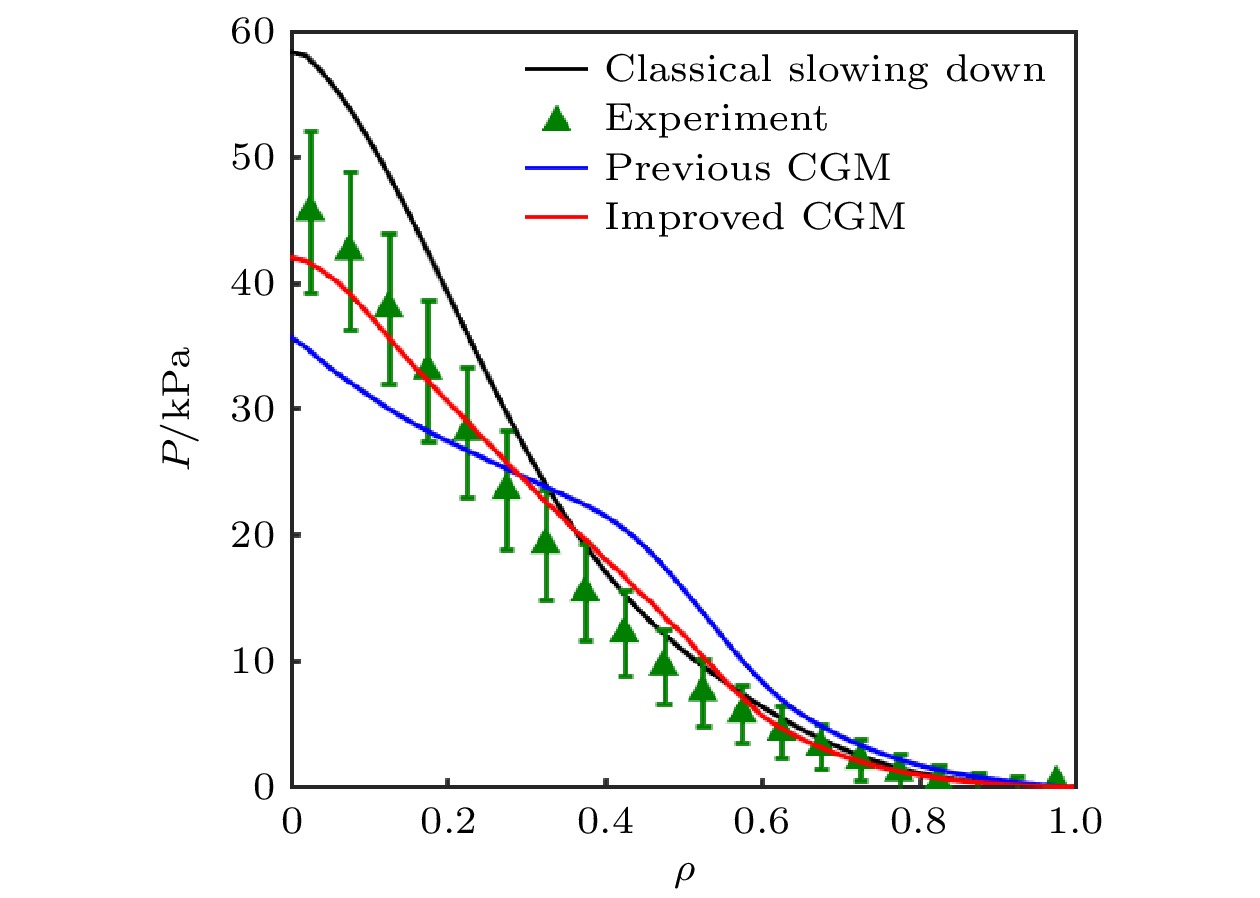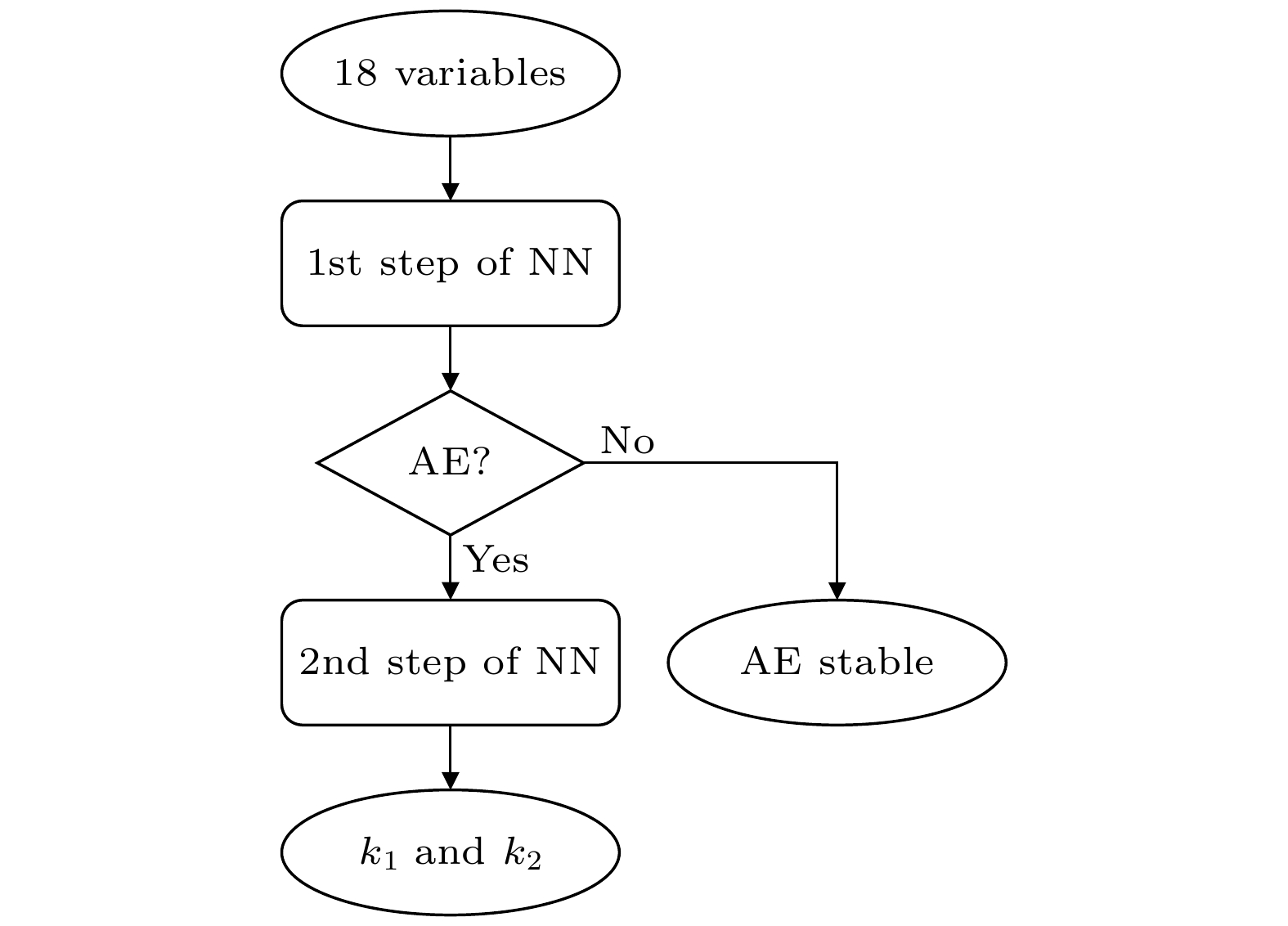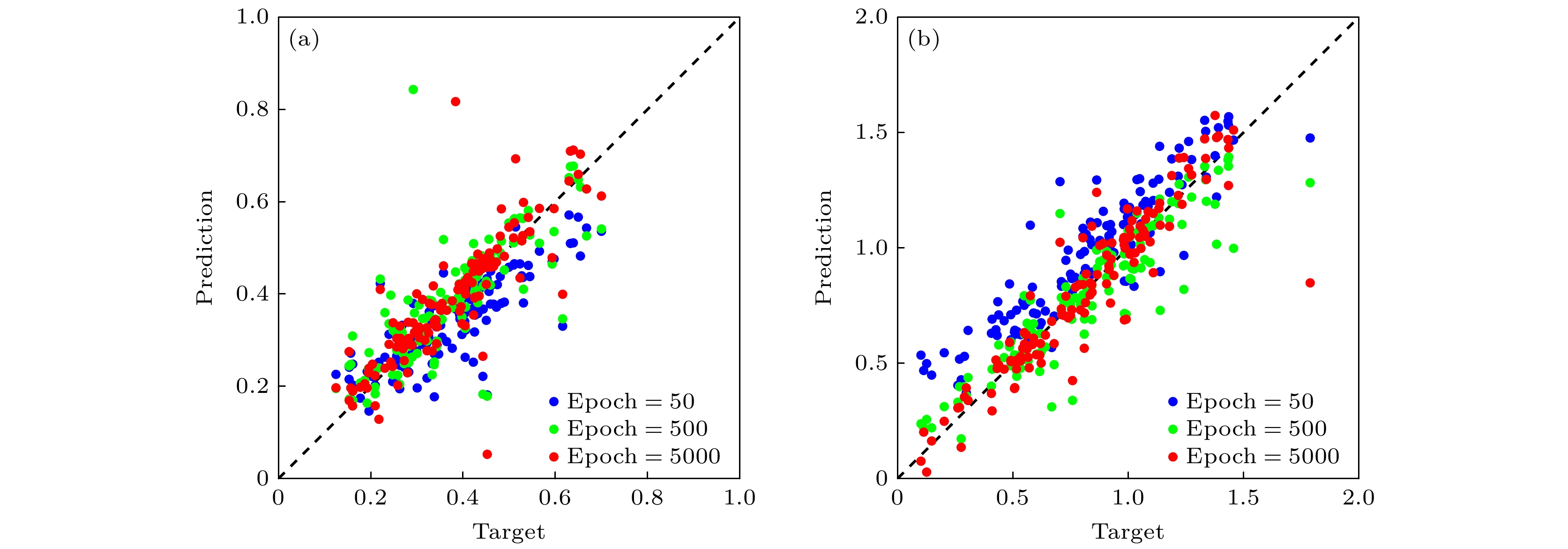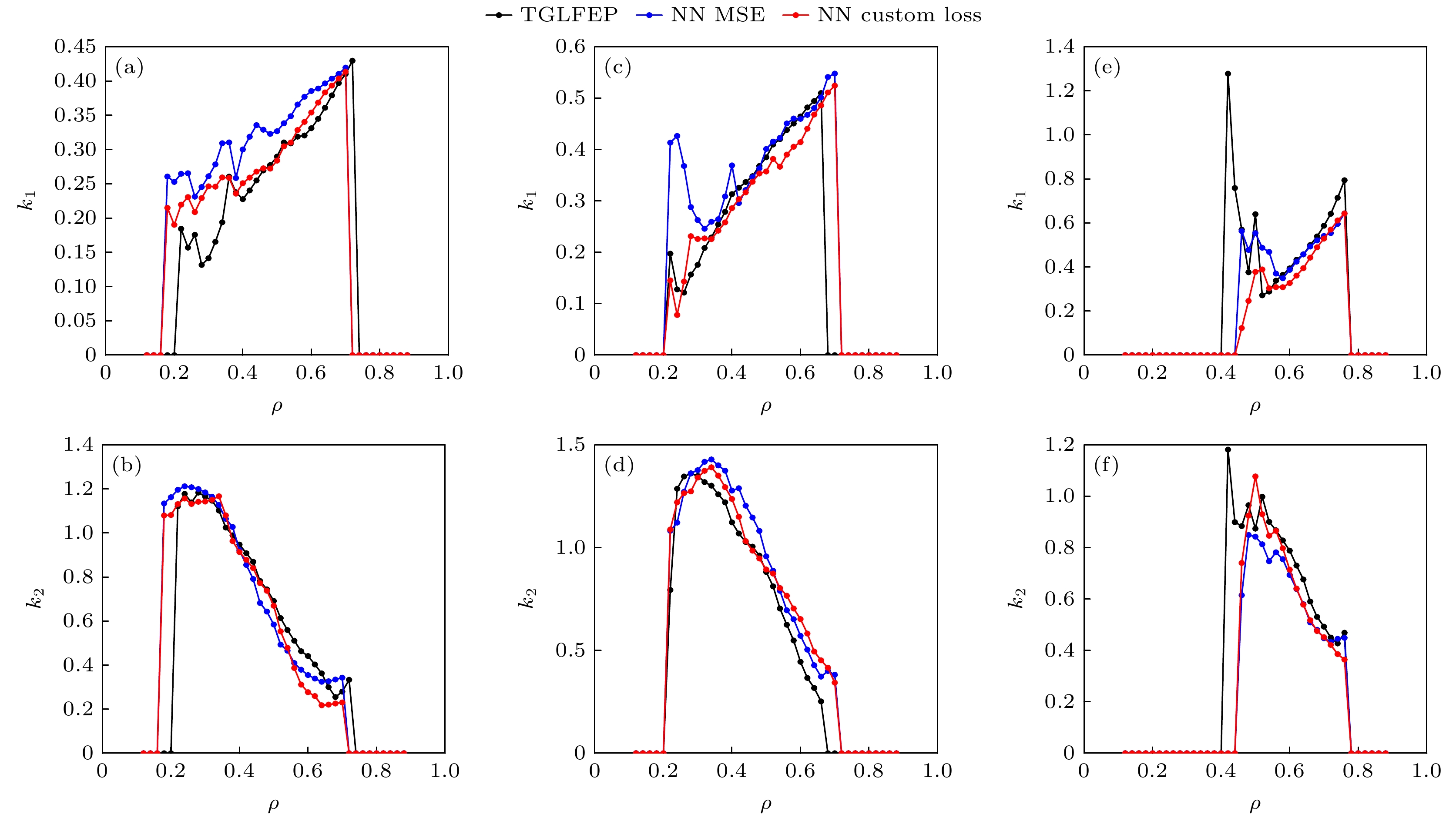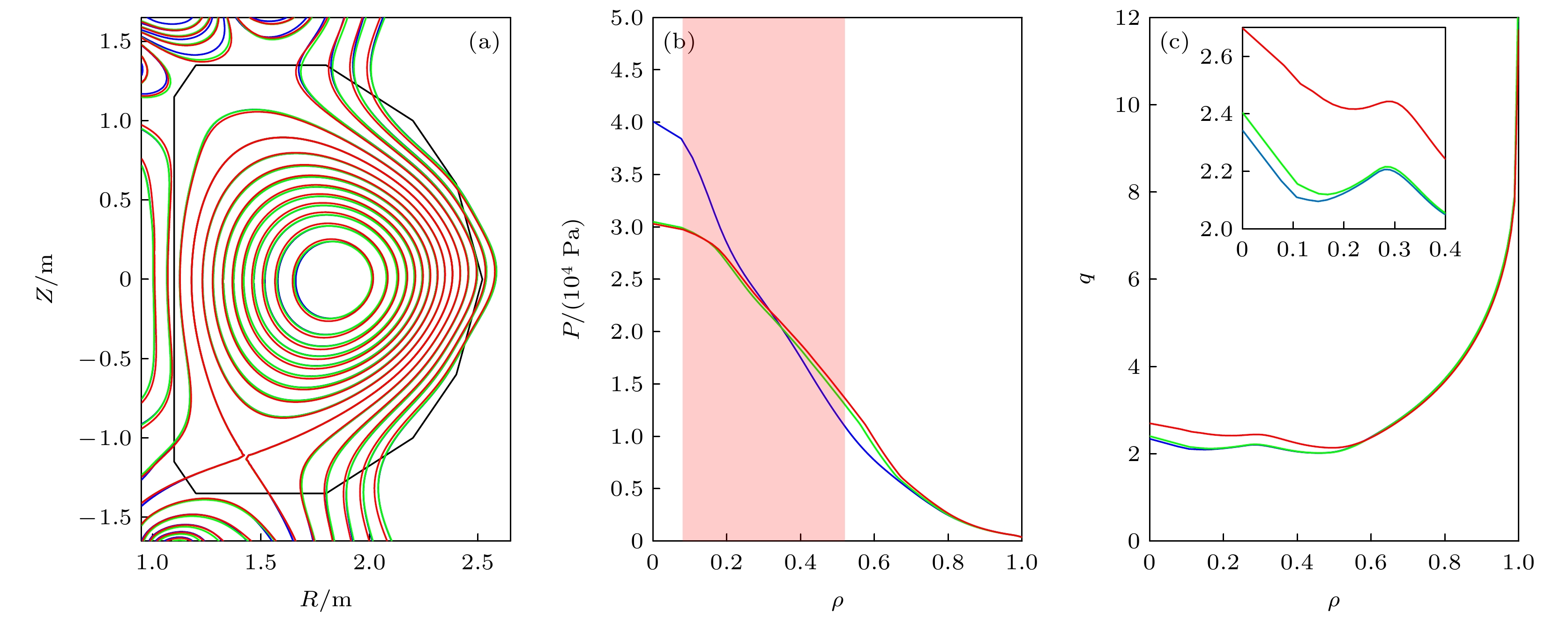-
基于临界梯度模型, 使用TGLFEP和EPtran两个程序可以模拟分析阿尔芬本征模引起的高能量粒子输运问题. 本文在原有模型的基础上, 加入了两点改进使模拟结果更接近实验. 其一, 考虑阈值剖面的演化过程. 判断阈值的物理量由密度梯度(dn/dr)改为归一化的密度梯度((dn/dr)/(n/a)), 并且使用TGLFEP模拟证明阈值与高能量粒子密度成反比例关系, 也就是说, 当密度降低时, 阈值会增大. 第二, 考虑有限轨道宽度效应. 使用OBRIT程序计算高能量粒子的损失锥, 并输入到EPtran程序中, 从而增加了一种高能量粒子的损失通道. 利用DIII-D#142111和#153071进行实验验证, 结果表示改进后的模型更接近实验. 最后, 利用神经网络代替TGLFEP计算临界梯度, 并实现EPtran的并行计算以缩短运行时间. 以此建立一个EP模块并加入到OMFIT集成模拟中, 模拟结果表示当阿尔芬本征模驱动高能量粒子输运, 会导致芯部的压强和电流降低, 从而提升当地的安全因子, 改变平衡位形.Based on the critical gradient model , the combination of the TGLFEP code and EPtran code is employed to predict energetic particle (EP) transport induced by Alfvén eigenmodes (AEs). To be consistent with the experimental results, the model was improved recently by taking into consideration the threshold evolution and orbit loss mechanism. The threshold is modified to be the normalized critical gradient ((dn/dr)/(n/a)) instead of the critical gradient (dn/dr), and the new threshold is defined as a function inversely proportional to the EP density as obtained by the TGLFEP code. Additionally, the EP loss cone calculated by ORBIT is added into the EPtran code, which provides an important additional core loss channel for EPs due to finite orbits. With these two improvements, the EP redistribution profiles are found to very well reproduce the experimental profiles of two DIII-D validation cases (#142111 and #153071) with multiple unstable AEs and large-scale EP transport. In addition, a neural network is established to replace TGLFEP for critical gradient calculation, and EPtran code is rewritten with parallel computing. Based on this, a module of EP is established and it is added into the integrated simulation of OMFIT framework. The integrated simulation of HL-3 with AE transported neutral beam EP profile indicates that EP transport reduces the total pressure and current as expected, but under some condition it could also raise the safety factor in the core.
-
Keywords:
- energetic particle /
- Alfvén eigenmode /
- critical gradient model /
- transport
[1] Wan Y X, Li J G, Liu Y, Wang X L, Chan V, Chen C G, Duan X R, Fu P, Gao X, Feng K M, Liu S L, Song Y T, Weng P D, Wan B N, Wan F R, Wang H Y, Wu S T, Ye M Y, Yang Q W, Zheng G Y, Zhuang G, Li Q 2017 Nucl. Fusion 57 102009
 Google Scholar
Google Scholar
[2] Zhuang G, Li G Q, Li J, Wan Y X, Liu Y, Wang X L, Song Y T, Chan V, Yang Q W, Wan B N, Duan X R, Fu P, Xiao B J 2019 Nucl. Fusion 59 112010
 Google Scholar
Google Scholar
[3] Gaffey J D Jr 1976 J. Plasma Phys. 16 149
 Google Scholar
Google Scholar
[4] Estrada-Mila C, Candy J, Waltz R E 2006 Phys. Plasmas 13 112303
 Google Scholar
Google Scholar
[5] Van Zeeland M A, Heidbrink W W, Fisher R K, García Muñoz M, Kramer G J, Pace D C, White R B, Aekaeslompolo S, Austin M E, Boom J E 2011 Phys. Plasmas 18 056114
 Google Scholar
Google Scholar
[6] Heidbrink W W, Collins C S, Podestà M, Kramer G J, Pace D C, Petty C C, Stagner L, van Zeeland M A, White R B, Zhu Y B 2017 Phys. Plasmas 24 056109
 Google Scholar
Google Scholar
[7] Garcia-Munoz M, Classen I G J, Geiger B, Heidbrink W W, van Zeeland M A, Äkäslompolo S, Bilato R, Bobkov V, Brambilla M, Conway C D, Schneller M, da Graça S, Igochine V, Lauber Ph, Luhmann N, Maraschek M, Meo F, Park H, Tardini G 2011 Nucl. Fusion 51 103013
 Google Scholar
Google Scholar
[8] Kiptily V G, von Thun C P, Pinches S D, Sharapov S E, Borba D, Cecil F E, Darrow D, Goloborod'ko V, Craciunescu T, Johnson T, Nabais F, Reich M, Salmi A, Yavorskij V, Cecconello M, Gorini G, Lomas P, Murari A, Parail V, Popovichev S, Saibene G, Sartori R, Syme D B, Tardocchi M, de Vries P, Zoita V L 2009 Nucl. Fusion 49 065030
 Google Scholar
Google Scholar
[9] Fredrickson E D, Cheng C Z, Darrow D, Fu G, Gorelenkov N N, Kramer G, Medley S S, Menard J, Roquemore L, Stutman D, White R B 2003 Phys. Plasmas 10 2852
 Google Scholar
Google Scholar
[10] Collins C S, Heidbrink W W, Austin M E, Kramer G J, Pace D C, Petty C C, Stagner L, Van Zeeland M A, White R B, Zhu Y B, DIII-D Team 2016 Phys. Rev. Lett. 116 095001
 Google Scholar
Google Scholar
[11] White R B, Chance M S 1984 Phys. Fluids 27 2455
 Google Scholar
Google Scholar
[12] Todo Y, Shinohara K, Takechi M, Ishikawa M, 2005 Phys. Plasmas 12 012503
 Google Scholar
Google Scholar
[13] Podestà M, Gorelenkova M, Gorelenkov N N, White R B 2017 Plasma Phys. Control. Fusion 59 095008
 Google Scholar
Google Scholar
[14] Bass E M , Waltz R E 2010 Phys. Plasmas 17 112319
[15] Collins C S, Heidbrink W W, Podestà M, White R B, Kramer G J, Pace D C, Petty C C, Stagner L, van Zeeland M A, Zhu Y B 2017 Nucl. Fusion 57 086005
 Google Scholar
Google Scholar
[16] van Zeeland M A, Gorelenkov N N, Heidbrink W W, Kramer G J, Spong D A, Austin M E, Fisher R K, García Muñoz M, Gorelenkova M, Luhmann N, Murakami M, Nazikian R, Pace1 D C, Park J M, Tobias B J, White R B 2012 Nucl. Fusion 52 094023
 Google Scholar
Google Scholar
[17] Heidbrink W W, Ferron J R, Holcomb C T, van Zeeland M A, Chen X, Collins C M, Garofalo A, Gong X, Grierson B A, Podestà M, Stagner L, Zhu Y 2014 Plasma Phys. Control. Fusion 56 095030
 Google Scholar
Google Scholar
[18] Podestà M, Gorelenkova M, White R B 2014 Plasma Phys. Control. Fusion 56 055003
 Google Scholar
Google Scholar
[19] He S, Waltz R E, Staebler G M 2017 Phys. Plasmas 24 072305
 Google Scholar
Google Scholar
[20] Staebler G M, Kinsey J E, Waltz R E 2005 Phys. Plasmas 12 102508
 Google Scholar
Google Scholar
[21] Chen L, Cheng C Z 1980 Phys. Fluids 23 2242-2249.
 Google Scholar
Google Scholar
[22] Lang J, Fu G Y, Chen Y 2010 Phys. Plasmas 17 042309
 Google Scholar
Google Scholar
[23] Waltz R E, Bass E M, Staebler G M 2013 Phys. Plasmas 20 042510
 Google Scholar
Google Scholar
[24] Waltz R E, Bass E M 2014 Nucl. Fusion 54 104006
 Google Scholar
Google Scholar
[25] Waltz R E, Bass E M, Heidbrink W W, van Zeeland M A 2015 Nucl. Fusion 55 123012
 Google Scholar
Google Scholar
[26] He S, Waltz R E 2016 Nucl. Fusion 56 056004
 Google Scholar
Google Scholar
[27] Betti R, Freidberg J P 1992 Phys. Fluids B Plasma Phys. 4 1465
 Google Scholar
Google Scholar
[28] Pankin A, McCune D, Andre R, Bateman G, Kritz A 2004 Comput. Phys. Commun. 159 157
 Google Scholar
Google Scholar
[29] Todo Y, Van Zeeland M A, Bierwage A., Heidbrink W W 2014 Nucl. Fusion 54 104012
 Google Scholar
Google Scholar
[30] White R B 2014 The Theory of Toroidally Confined Plasmas (3rd Ed.) (Imperial College Press) pp82–90
-
图 1 (a)增长率和(b)频率与高斯宽度的关系, 其中橙色和紫色的曲线表示TAE, 蓝色线被认为是一种数值噪声, 作为参考, 黑色实线为MEGA的模拟结果
Fig. 1. (a) Growth rate and (b) frequency as a function of Gaussian width. The orange and purple curves represent acceptable TAE calculated using TGLFEP. Because the blue curve has a strong perturbation, the mode is treated as polluted by numerical noise. For comparison, the MEGA results are depicted by the black lines.
图 3 (a)输运前的AE不稳定区间; (b)在ρ = 0.4, 0.5, 0.6处, a/LnEP与nEP的反比例关系; (c) ρ = 0.4处, 旧模型和改进模型模拟的密度演化轨迹
Fig. 3. (a) Unstable AE region of n = 3 without transport. Critical a/LnEP is depicted by dash red curve, and a/LnEP of classical slowing down distribution is depicted by solid black curve; (b) inverse proportional function between critical a/LnEP and nEP at ρ = 0.4, 0.5, 0.6; (c) density evolution trajectories of previous CGM (black) and improved CGM (red) at ρ = 0.4.
图 5 (a)无扰动时, 不同能量EP在(ρ, v///v)空间的损失锥; (b)有无AE扰动下, 80 keV的EP损失锥对比图
Fig. 5. (a) Loss boundary in (ρ, v///v) space with different energies; the loss region is on the right side of the curve. (b) loss cone without/with AE perturbation. The blue area represents the loss cone without AE, and the additional loss by including AE is highlighted by the red area.
图 8 (a) EP密度剖面对比图, 经典慢化分布(黑色)、实验(红色)、旧临界梯度模型(蓝色)、考虑(紫色)/不考虑(绿色)AE扰动对损失锥影响的改进的临界梯度模型、MEGA(黄色); (b) EP在螺旋角空间的分布
Fig. 8. (a) Density profile comparison: Black curve represents classical slowing down; the red curve is inferred from experiment data; blue curve represents original CGM without loss cone effect; purple/green curve is improved CGM with loss cone from AE perturbed/unperturbed orbits; yellow curve represents MEGA results. (b) EP redistribution in pitch angle space.
图 16 HL-3神经网络预测值(MSE为蓝色, 自定义损失函数为红色)与TGLFEP计算值(黑色)对比图 (a), (b) Case 1; (c), (d) Case 2; (e), (f) Case 3
Fig. 16. Coefficients of k1 and k2 predicted by NN with loss function of MSE (blue) and custom loss function (red): (a), (b) Case 1; (c), (d) Case 2; (e), (f) Case 3. For comparison, TGLFEP results are depicted by black curve.
图 17 具有(a)单调递增、(b)芯部弱反磁剪切和(c)强反磁剪切安全因子剖面的平衡位形下, 高能量粒子剖面对比图. 绿色曲线为经典慢化模型计算的初始EP剖面, 黑色、蓝色、红色曲线分别为根据TGLFEP、MSE和自定义损失函数得到的临界梯度计算的EP剖面
Fig. 17. EP profile comparison for the equilibrium with (a) monotonic, (b) weak and (c) strong shear q-profile. In each panel, green curve depicts initial EP profile with classical slowing down distribution and black curve depicts EP profile with the critical gradient calculated by TGLFEP. The blue and red curves depict EP profiles by NN with loss function of MSE and custom loss function, respectively.
图 19 利用带有MOE的集成模拟计算的(a)磁面、(b)总压强、(c)安全因子剖面, 其中绿线仅考虑了EP输运对总压强的影响, 红线考虑了EP输运对压强和电流的影响, 蓝线则为不包含MOE的集成模拟的结果
Fig. 19. (a) Flux surface, (b) total pressure and (c) safety factor profile calculated by the OMFIT integrated simulation with MOE. Green curve only considers pressure modification, red curve considers both pressure and current modification, and blue curve is calculated without MOE.
表 1 神经网络输入变量
Table 1. Variables for NN input
变量 符号 表达式 1 电子密度 ne 2 电子温度 Te 3 电子密度特征长度 rlns_e $ -\displaystyle\frac{a}{{n}_{{\rm{e}}}}\frac{\partial {n}_{{\rm{e}}}}{\partial r} $ 4 电子温度特征长度 rlts_e $ -\displaystyle\frac{a}{{T}_{{\rm{e}}}}\frac{\partial {T}_{{\rm{e}}}}{\partial r} $ 5 磁面对应的小半径 rmin $ {r}/{a} $ 6 安全因子 q 7 磁剪切 q_prime $ \displaystyle\frac{{q}^{2}{a}^{2}}{{r}^{2}}s $ 8 压强梯度 p_prime $ \displaystyle\frac{q{a}^{2}}{r{B}^{2}}\frac{\partial p}{\partial r} $ 9 高能量粒子温度 taus_EP TEP/Te 10 高能量粒子温度特征长度 rlts_EP $ -\displaystyle\frac{a}{{T}_{{\rm{E}}{\rm{P}}}}\frac{\partial {T}_{{\rm{E}}{\rm{P}}}}{\partial r} $ 11 磁场强度 B 12 磁面对应的大半径 rmaj $ {R}/{a} $ 13 拉长比 kappa κ 14 拉长比的剪切 s_kappa $ \displaystyle\frac{r}{\kappa }\frac{\partial \kappa }{\partial r} $ 15 三角形变 delta δ 16 三角形变的剪切 s_delta $ \displaystyle\frac{r}{\delta }\frac{\partial \delta }{\partial r} $ 17 Shafranov位移 drmajdx $ \displaystyle\frac{\partial R}{\partial x} $ 18 小半径 a -
[1] Wan Y X, Li J G, Liu Y, Wang X L, Chan V, Chen C G, Duan X R, Fu P, Gao X, Feng K M, Liu S L, Song Y T, Weng P D, Wan B N, Wan F R, Wang H Y, Wu S T, Ye M Y, Yang Q W, Zheng G Y, Zhuang G, Li Q 2017 Nucl. Fusion 57 102009
 Google Scholar
Google Scholar
[2] Zhuang G, Li G Q, Li J, Wan Y X, Liu Y, Wang X L, Song Y T, Chan V, Yang Q W, Wan B N, Duan X R, Fu P, Xiao B J 2019 Nucl. Fusion 59 112010
 Google Scholar
Google Scholar
[3] Gaffey J D Jr 1976 J. Plasma Phys. 16 149
 Google Scholar
Google Scholar
[4] Estrada-Mila C, Candy J, Waltz R E 2006 Phys. Plasmas 13 112303
 Google Scholar
Google Scholar
[5] Van Zeeland M A, Heidbrink W W, Fisher R K, García Muñoz M, Kramer G J, Pace D C, White R B, Aekaeslompolo S, Austin M E, Boom J E 2011 Phys. Plasmas 18 056114
 Google Scholar
Google Scholar
[6] Heidbrink W W, Collins C S, Podestà M, Kramer G J, Pace D C, Petty C C, Stagner L, van Zeeland M A, White R B, Zhu Y B 2017 Phys. Plasmas 24 056109
 Google Scholar
Google Scholar
[7] Garcia-Munoz M, Classen I G J, Geiger B, Heidbrink W W, van Zeeland M A, Äkäslompolo S, Bilato R, Bobkov V, Brambilla M, Conway C D, Schneller M, da Graça S, Igochine V, Lauber Ph, Luhmann N, Maraschek M, Meo F, Park H, Tardini G 2011 Nucl. Fusion 51 103013
 Google Scholar
Google Scholar
[8] Kiptily V G, von Thun C P, Pinches S D, Sharapov S E, Borba D, Cecil F E, Darrow D, Goloborod'ko V, Craciunescu T, Johnson T, Nabais F, Reich M, Salmi A, Yavorskij V, Cecconello M, Gorini G, Lomas P, Murari A, Parail V, Popovichev S, Saibene G, Sartori R, Syme D B, Tardocchi M, de Vries P, Zoita V L 2009 Nucl. Fusion 49 065030
 Google Scholar
Google Scholar
[9] Fredrickson E D, Cheng C Z, Darrow D, Fu G, Gorelenkov N N, Kramer G, Medley S S, Menard J, Roquemore L, Stutman D, White R B 2003 Phys. Plasmas 10 2852
 Google Scholar
Google Scholar
[10] Collins C S, Heidbrink W W, Austin M E, Kramer G J, Pace D C, Petty C C, Stagner L, Van Zeeland M A, White R B, Zhu Y B, DIII-D Team 2016 Phys. Rev. Lett. 116 095001
 Google Scholar
Google Scholar
[11] White R B, Chance M S 1984 Phys. Fluids 27 2455
 Google Scholar
Google Scholar
[12] Todo Y, Shinohara K, Takechi M, Ishikawa M, 2005 Phys. Plasmas 12 012503
 Google Scholar
Google Scholar
[13] Podestà M, Gorelenkova M, Gorelenkov N N, White R B 2017 Plasma Phys. Control. Fusion 59 095008
 Google Scholar
Google Scholar
[14] Bass E M , Waltz R E 2010 Phys. Plasmas 17 112319
[15] Collins C S, Heidbrink W W, Podestà M, White R B, Kramer G J, Pace D C, Petty C C, Stagner L, van Zeeland M A, Zhu Y B 2017 Nucl. Fusion 57 086005
 Google Scholar
Google Scholar
[16] van Zeeland M A, Gorelenkov N N, Heidbrink W W, Kramer G J, Spong D A, Austin M E, Fisher R K, García Muñoz M, Gorelenkova M, Luhmann N, Murakami M, Nazikian R, Pace1 D C, Park J M, Tobias B J, White R B 2012 Nucl. Fusion 52 094023
 Google Scholar
Google Scholar
[17] Heidbrink W W, Ferron J R, Holcomb C T, van Zeeland M A, Chen X, Collins C M, Garofalo A, Gong X, Grierson B A, Podestà M, Stagner L, Zhu Y 2014 Plasma Phys. Control. Fusion 56 095030
 Google Scholar
Google Scholar
[18] Podestà M, Gorelenkova M, White R B 2014 Plasma Phys. Control. Fusion 56 055003
 Google Scholar
Google Scholar
[19] He S, Waltz R E, Staebler G M 2017 Phys. Plasmas 24 072305
 Google Scholar
Google Scholar
[20] Staebler G M, Kinsey J E, Waltz R E 2005 Phys. Plasmas 12 102508
 Google Scholar
Google Scholar
[21] Chen L, Cheng C Z 1980 Phys. Fluids 23 2242-2249.
 Google Scholar
Google Scholar
[22] Lang J, Fu G Y, Chen Y 2010 Phys. Plasmas 17 042309
 Google Scholar
Google Scholar
[23] Waltz R E, Bass E M, Staebler G M 2013 Phys. Plasmas 20 042510
 Google Scholar
Google Scholar
[24] Waltz R E, Bass E M 2014 Nucl. Fusion 54 104006
 Google Scholar
Google Scholar
[25] Waltz R E, Bass E M, Heidbrink W W, van Zeeland M A 2015 Nucl. Fusion 55 123012
 Google Scholar
Google Scholar
[26] He S, Waltz R E 2016 Nucl. Fusion 56 056004
 Google Scholar
Google Scholar
[27] Betti R, Freidberg J P 1992 Phys. Fluids B Plasma Phys. 4 1465
 Google Scholar
Google Scholar
[28] Pankin A, McCune D, Andre R, Bateman G, Kritz A 2004 Comput. Phys. Commun. 159 157
 Google Scholar
Google Scholar
[29] Todo Y, Van Zeeland M A, Bierwage A., Heidbrink W W 2014 Nucl. Fusion 54 104012
 Google Scholar
Google Scholar
[30] White R B 2014 The Theory of Toroidally Confined Plasmas (3rd Ed.) (Imperial College Press) pp82–90
计量
- 文章访问数: 1225
- PDF下载量: 44
- 被引次数: 0














 下载:
下载:


